|
|
|
Neutron Science Laboratory and Meson Science Laboratore
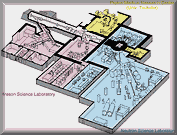
Neutron Science Laboratory and Meson Science Laboratory were established in 1978 as Booster Synchrotron Utilization Facility in the National Laboratory for High Energy Physics. At the facility, the first pulsed spallation neutron scattering program, the pulsed muon experiments and a proton therapy by Proton Medical Research Center (University of Tsukuba) started in 1980 using a 500 MeV proton synchrotron. Since then, many pioneering scientific researches and technical developments have been made. Now the Neutron and Meson Labs are two of the important facilities of Institute of Materials Structure Science in KEK along with the Photon Factory.
In the near future, neutron and meson facilities will be transformed to be the N-arena and M-arena of Japan Hadron Facility (JHF) Project, respectively. In 1997, University of Tsukuba started construction of a new hospital-based proton synchrotron for cancer therapy in the university campus after the success in KEK. See more detail in following pages.
Neutron Science Laboratory
Neurtron Science Laboratory realized the first practical spallation neutron source (KENS) for neutron scattering researches in the world (1980). High-energy pulsed neutrons are produced by the spallation reaction with the proton beam of 500 MeV and are modelated with water at room temperature and a solid methane at 20 K to become thermal and cold neutrons, respectively. These moderated neutrons are delivered to 17 neutron spectrometers through 11 neutron beam holes in the biological shield.
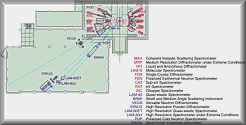 Several new spectrometers with novel ideas, for example, large-mirror-type spectrometers (LAM-40,-80ET and -D), an eV spectrometer (RAT), a pulsed small-angle-scattering spectrometer (SWAN), powder diffractometers with 2-D PSD-detector-banks (VEGA and SIRIUS) as well as polarized cold and epithermal neutron spectrometers (TOP and PEN) were realized for the first time. These have been used in many scientific fields such as biology, chemistry, condensed matter physics and nuclear physics. The structure study of high-Tc superconductor, 1 meV-resolution spectroscopy of molecular tunneling, the study of parity violation in neutron-nucleus interaction and the direct observation of the Bose condensation in the superfluid He-4 are excellent examples of prominent outputs at KENS.
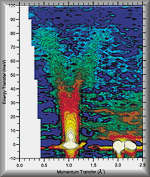 |
Scattering contour map of the magnetic excitations from CsVCI3 |
The fruitful results at KENS have been based on many R&D activities over various range. KENS has developed a solid-methane cold moderator, a high-efficiency target-moderator-reflector assembly for the future high-power neutron source, position-sensitive neutron-detector system, dynamical proton filter, He-3 polarizer, pulsed magnet, ultra-cold neutron and super-thermal technology, etc.
These pioneering works gave great influence in the neutron science, especially to many overseas facilities such as IPNS at Argonne National Laboratory, ISIS at Rutherford Appleton Laboratory and LANSCE at Los Alamos National Laboratory which were constructed after KENS started. Those have also played important roles for the successful construction of a new novel chopper spectrometer MARI and a high performance spectrometer MAPS under the Japan-UK collaboration program.
 |
Neutron Science Laboratory is led by Hironobu IKEDA who has been the laboratory director since 1995. |
KENS has been playing an important role as a national center of neutron science in Japan. Scientific proposals of more than 100 a year have been submitted as the Inter-University Research Program at KENS. About 400 researchers visit KENS for research work with KENS spectrometers and several tens of publications have been made by using KENS experiments every year. Several workshops on research activities with KENS have been held annually.
This facility is widely open to scientists both from inside and outside of Japan.
Recently, Francis FILLAUX, Michael STEINER, Colin CARLILE, Jack CARPENTER, Gordon KEARLEY and others have done experiments at KENS with great sucess.
In recent years, there is a characteristic trend of the oversubscription; the total number of the submitted proposals is steadily increasing while the number of experiments accepted has become saturated. For such increasing demands of neutron scattering researches, the construction of a new intense spallation neutron source is now planned in N-arena of the JHF project.
Meson Science Laboratory
The Meson Science Laboratory started in 1980 in KEK site as the first experimental facility of intense pulsed muons in the world using sharply pulsed (50 ns pulse width and 20 Hz repetition) muon beam. Since then, the laboratory was operated as a part of the Faculty of Science, University of Tokyo. In April, 1997, this laboratory joined KEK to form a new organization.
Presently, three types of beam channels are producing pulsed muons for scientific researches ;
| a |
a superconducting muon channel for up to 100 MeV positive and negative muons produced from the decay of pions in flight through a 5 T superconducting solenoid, 6 m long and 12 cm diameter, |
| b |
a surface muon channel for 4 MeV positive muons produced from pion decay at the surface of the pion production target of Be, and |
| c |
an ultra-slow muon channel for 10 keV positive muon production by utilizing phenomenon discovered and developed in the Meson Science Laboratory, namely, thermal muonium (a neutral hydrogen-like bound state of a positive muon and an electron) extraction into a vacuum from the surface of hot tungsten and laser resonant ionization of the muonium. |
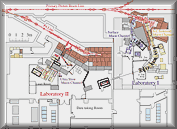 |
|
 |
Lasers for Ultra-Slow Positive Muon Production |
Various spectrometers with advanced equipments have been installed including a 10 mK dilution refrigerator and a 4 T longitudinal magnetic field source for condensed matter studies.
Excellent features of pulsed muons have been recognized and used for the realizations of various important discoveries. This influenced muon science facilities such as ISIS at the Rutherford Appleton Laboratory.
These features can be summarized as follows.
| a |
Muon-decay associated phenomena such as muon spin rotation/relaxation/resonance studies can easily be measured in a long time range up to more than 10 life-times, revealing the microscopic magnetic behavior as well as light particle diffusion phenomena in condensed matter. |
| b |
Pulsed extreme experimental conditions can easily be applied in muon experiment realizing muon spin RF resonance as well as laser resonance of the muon states. |
| c |
Measurement capability of a muon-associated weak signal against white-noise background (phase-sensitive detection). |
Distinguished discoveries include, quantum diffusion of positive muon in copper, magnetism in high temperature superconducting materials, final state spectroscopy of chemical channel reaction of muon/muonium in solid, elementary excitation induced by muons in conducting polymer, muon/muonium centers in illuminated semiconductor, thermal muonium production in vacuum, muonium 1s-2s laser-resonance spectroscopy, muon-to-alpha sticking X-ray in D-T muon catalyzed fusion, etc.
world and distinguished scientists have enjoyed a long stay to produce remarkable scientific outputs. To name a few, Steven CHU, Allen MILLS Jr., Steven JONES, Donald FLEMING, Jess BREWER, Anthony ARROT and Alexander SCHENCK are the recent visitors.
Due to limited beam-time and weak intensity, it is becoming very hard to fully satisfy the requests of many excellent experimental proposals from all over the world. The realizations of the M-arena of the JHF project is inevitably important.
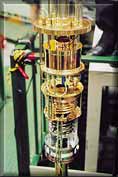 |
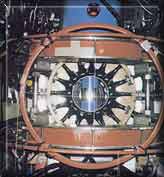 |
|
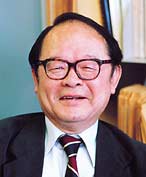 |
Very Low Temperature Set-up at Surface Muon Port |
The Meson Science laboratory is led by Kanetada NAGAMINE who has been the laboratory director since 1997. |
|
|
